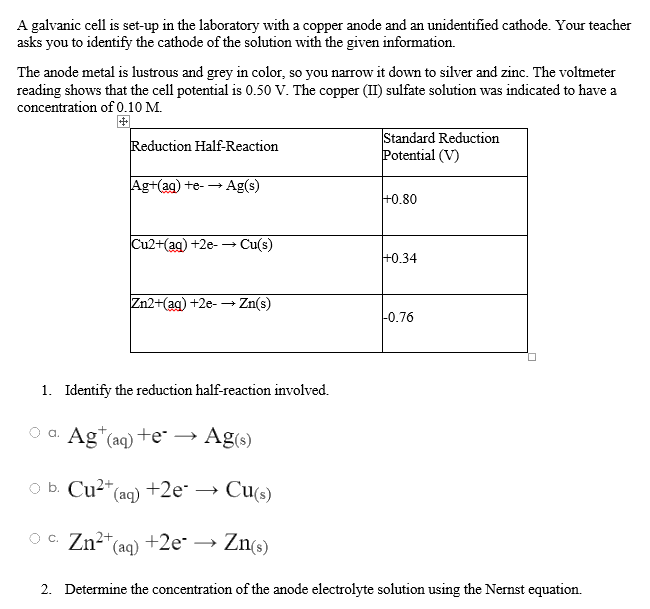A galvanic cell is set-up in the laboratory with a copper anode and an unidentified cathode. Your teacher asks you to identify the cathode of the solution with the given information. The anode metal is lustrous and grey in color, so you narrow it down to silver and zinc. The voltmeter reading shows that the cell potential is 0.50 V. The copper (II) sulfate solution was indicated to have a concentration of 0.10 M. Reduction Half-Reaction Standard Reduction Potential (V) Ag+(ag) +e- → Ag(s) +0.80 Cu2+(aq) +2e- Cu(s) +0.34 Zn2+(ag) +2e-→ Zn(s) -0.76 1. Identify the reduction half-reaction involved. O a. Ag (aq) +e → Ag(s) O b. Cu²+ (aq) +2e → Cu(s) O c. Zn²+ (aq) +2e- Zn(s) 2. Determine the concentration of the anode electrolyte solution using the Nernst equation. →
A galvanic cell is set-up in the laboratory with a copper anode and an unidentified cathode. Your teacher asks you to identify the cathode of the solution with the given information. The anode metal is lustrous and grey in color, so you narrow it down to silver and zinc. The voltmeter reading shows that the cell potential is 0.50 V. The copper (II) sulfate solution was indicated to have a concentration of 0.10 M. Reduction Half-Reaction Standard Reduction Potential (V) Ag+(ag) +e- → Ag(s) +0.80 Cu2+(aq) +2e- Cu(s) +0.34 Zn2+(ag) +2e-→ Zn(s) -0.76 1. Identify the reduction half-reaction involved. O a. Ag (aq) +e → Ag(s) O b. Cu²+ (aq) +2e → Cu(s) O c. Zn²+ (aq) +2e- Zn(s) 2. Determine the concentration of the anode electrolyte solution using the Nernst equation. →
Chemistry: Principles and Practice
3rd Edition
ISBN:9780534420123
Author:Daniel L. Reger, Scott R. Goode, David W. Ball, Edward Mercer
Publisher:Daniel L. Reger, Scott R. Goode, David W. Ball, Edward Mercer
Chapter18: Electrochemistry
Section: Chapter Questions
Problem 18.49QE: A half-cell that consists of a copper wire in a 1.00 M Cu(NO3)2 solution is connected by a salt...
Related questions
Question

Transcribed Image Text:A galvanic cell is set-up in the laboratory with a copper anode and an unidentified cathode. Your teacher
asks you to identify the cathode of the solution with the given information.
The anode metal is lustrous and grey in color, so you narrow it down to silver and zinc. The voltmeter
reading shows that the cell potential is 0.50 V. The copper (II) sulfate solution was indicated to have a
concentration of 0.10 M.
Reduction Half-Reaction
Standard Reduction
Potential (V)
Ag+(ag) +e-→ Ag(s)
+0.80
Cu2+(ag) +2e-→ Cu(s)
+0.34
Zn2+(ag) +2e- → Zn(s)
-0.76
1. Identify the reduction half-reaction involved.
o a. Agt(aq) +e--
Ag(s)
O b. Cu²+ (aq) +2e
→ Cu(s)
c. Zn²+ (aq) +2e-
Zn(s)
2. Determine the concentration of the anode electrolyte solution using the Nernst equation.
Expert Solution
This question has been solved!
Explore an expertly crafted, step-by-step solution for a thorough understanding of key concepts.
Step by step
Solved in 2 steps with 2 images

Knowledge Booster
Learn more about
Need a deep-dive on the concept behind this application? Look no further. Learn more about this topic, chemistry and related others by exploring similar questions and additional content below.Recommended textbooks for you

Chemistry: Principles and Practice
Chemistry
ISBN:
9780534420123
Author:
Daniel L. Reger, Scott R. Goode, David W. Ball, Edward Mercer
Publisher:
Cengage Learning

Principles of Modern Chemistry
Chemistry
ISBN:
9781305079113
Author:
David W. Oxtoby, H. Pat Gillis, Laurie J. Butler
Publisher:
Cengage Learning

Chemical Principles in the Laboratory
Chemistry
ISBN:
9781305264434
Author:
Emil Slowinski, Wayne C. Wolsey, Robert Rossi
Publisher:
Brooks Cole

Chemistry: Principles and Practice
Chemistry
ISBN:
9780534420123
Author:
Daniel L. Reger, Scott R. Goode, David W. Ball, Edward Mercer
Publisher:
Cengage Learning

Principles of Modern Chemistry
Chemistry
ISBN:
9781305079113
Author:
David W. Oxtoby, H. Pat Gillis, Laurie J. Butler
Publisher:
Cengage Learning

Chemical Principles in the Laboratory
Chemistry
ISBN:
9781305264434
Author:
Emil Slowinski, Wayne C. Wolsey, Robert Rossi
Publisher:
Brooks Cole

Chemistry
Chemistry
ISBN:
9781305957404
Author:
Steven S. Zumdahl, Susan A. Zumdahl, Donald J. DeCoste
Publisher:
Cengage Learning

Chemistry: An Atoms First Approach
Chemistry
ISBN:
9781305079243
Author:
Steven S. Zumdahl, Susan A. Zumdahl
Publisher:
Cengage Learning
